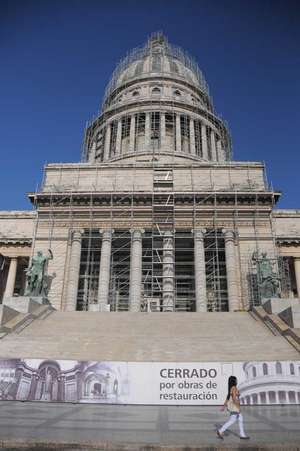
Ivan Garcia, 28 June 2016 — The northern end of the “Capitolio,” Cuba’s National Capitol, is already completely restored. Scaffolding has now been erected at the southern end of the colossal building
Some of the beautiful gardens and wrought iron lampposts surrounding it have been rescued. The hustle and bustle of construction workers and technicians is constant.
Sections of the Paseo del Prado surrounding the Capitolio have been restored. The avenue’s new pavement is made from cast concrete and parking has been banned. Dozens of palm trees have also been planted and streetlights installed.
Three months ago the state-run Cuban News Agency reported that, beginning in April of 2016, the National Assembly of People’s Power would occupy the north end of the building, though this has not been confirmed.
Ileana Mulet, head of the Office of the Historian’s Prado Investment Group, was quoted by the official press as saying that air conditioning had been installed in part of the lower floor and well as on the third and fourth floors, noting that the work would not affect the chambers’ aesthetics.
Mulet confirmed that security systems appropriate to a building of this type were being installed, including technology to detect explosives and break-ins as well as closed circuit television.
The investment specialist added that each seat in the semi-circular legislative chamber — the space where National Assembly deputies will meet only twice a year — will offer simultaneous translation, electronic voting, a telephone and internet access.
Some 90% of the materials used in the restoration are imported, mainly marble from Italy, which she notes “has on many occasions impacted the speed at which the restoration is being carried out.”
The restoration project is supposed to be completed by 2018, though Mulet acknowledges that the work “is far behind schedule.” The city’s Office of the Historian will be responsible for maintenance and conservation of the building.
A cabinetmaker working on the project estimates that, in the best case scenario, the Capitolio’s completion date “could be the middle of 2019 or even the beginning of 2020.”
Cuba’s National Capitol was built in four years under the direction of architect Eugenio Raynieri Piedra, who was appointed by Cuba’s president at the time, Gerardo Machado. It was inaugurated in 1929 and housed both chambers of Congress, the Republic of Cuba’s legislative body.
Inspired by the US Capitol, the building has a neo-classical facade and a dome which measures 91.73 meters at its highest point. Situated in the center of the capital and bordered by Prado, Dragones, Industria and San Jose streets, the Capitolio marks the official starting point of the 1,139-kilometer-long Central Highway, built between 1927 and 1931.
After Fidel Castro took power in January 1959, Congress was dissolved and the building became the headquarters of the Ministry of Science, Technology and the Environment as well as the Academy of Sciences.
For some analysts, the future home of the well-trained one-note parliament raises some interesting issues.
In 1958 legislative power on the island was held by two chambers: the House of Representatives and the Senate, which was made up of fifty-four senators, nine for each of the then six provinces (Pinar del Rio, Havana, Matanzas, Las Villas, Camagüey and Oriente). The House of Representatives had one delegate for every 35,000 constituents or fractions thereof larger than 17,500 constituents. Both chambers combined had a total 220 members (for a population of six million).
The current National Assembly has 612 members for a population of slightly over eleven million. But the numbers do not add up.
The chamber of the House of Representatives contains only two-hundred seats. If — as specialists from the Office of the Historian insist — physical changes to the Capitolio are being carried out without violating its original design, the million-dollar question is: How will it work if 412 members do not have a place to sit?
It is clear the current National Assembly is bloated. It is proportionally larger than the legislature of China, a country with more than 1.3 billion people.
A new election law has been brewing in the sewers of power for the last three years. Presumably, it will reduce the number of delegates while expanding their privileges and autonomy.
For now, everything is speculation. Another interesting question is how sessions of the National Assembly will be conducted. When the Capitolio was the legislative seat of the Cuban republic, its meetings were open to the public.
Even Cuba’s 1976 constitution — a carbon copy of the Soviet constitution — anticipated sessions would be open the public, something that has never occurred.
These are not the only questions. Moving to the Capitolio will involve reforms to the constitution, of which there have been many rumors.
There are several events that happen to coincide. Raul Castro will retire in 2018, probably before the Capitolio becomes fully operational.
The outlines of the Cuban political scene is becoming a conundrum due to a lack of transparency.
What is evident is that the island’s autocratic system of government might endure long after the Castro brothers are gone.
With the Capitolio or without the Capitolio.
